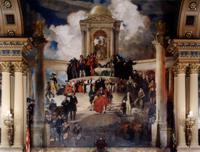Edwin Austin Abbey (1852-1911)Edwin Austin Abbey was one of the most celebrated illustrative artists of his day. Born in Philadelphia, he briefly studied art at the Pennsylvania Academy under Christian Schuessele. Before he was twenty years old, he was enjoying a brilliant career as an illustrator of poetry and drama for Harper's Weekly. Then in the late 1870s, Abbey left America for England to pursue a career as a large-scale history painter. While in England, he was elected to the Royal Academy and admitted to the elite artistic circle of the Pre-Raphaelites. As a result of his growing reputation at home and abroad, Abbey was about to undertake what would become his most famous commission. He was invited by American sculptor Auguste Saint-Gaudens in 1890 to produce the mural cycle The Quest for the Holy Grail for the McKim, Mead, and White Boston Public Library, which was completed in 1901. When Abbey was given his largest commission in 1902 to decorate the House and Senate Chambers, the Supreme and Superior Court Room, and rotunda in the Pennsylvania Capitol, the artist knew that this monumental project inaugurated a new phase in his career. Thus, he turned all of his energies to this project that he saw as his personal tribute to Pennsylvania and its history. Abbey executed the Capitol murals in his studio in England. By the spring of 1908, all murals for the rotunda were complete. They were exhibited at the University of London, where they received the highest acclaim. King Edward VII himself expressed regret that these magnificent paintings were leaving England. By 1909 the murals for the Capitol rotunda had been shipped to Harrisburg and were placed at the collar of the dome. Four large circular canvases, 14 feet in circumference, were installed in the pendentives. The four huge crescent-shaped murals, measuring 38 feet by 22 feet, were placed in the lunettes of the rotunda. When Abbey died suddenly in 1911, his widow administered the completion and installation of the House murals. The artist had completed three works for the House: The Apotheosis of Pennsylvania, Penn's Treaty, and The Hours, the latter of which is located on the ceiling. The Reading of the Declaration of Independence for the House Chamber had been partially completed. This painting was finished by Ernest Board, a member of Abbey's studio, under the supervision of John Singer Sargent, a close personal friend and neighbor. Only one mural had been executed for the Senate chamber entitled The Camp of the American Army at Valley Forge, February 1778. This painting, completed in 1910, had originally been placed in the Senate Chamber. As a result of Abbey's untimely death, it was removed and relocated onto a north wall in the rear of the House Chamber where it remains today. |


